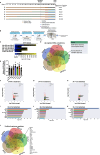Specific exercise patterns generate an epigenetic molecular memory window that drives long-term memory formation and identifies ACVR1C as a bidirectional regulator of memory in mice
- PMID: 38714691
- PMCID: PMC11076285
- DOI: 10.1038/s41467-024-47996-w
Specific exercise patterns generate an epigenetic molecular memory window that drives long-term memory formation and identifies ACVR1C as a bidirectional regulator of memory in mice
Abstract
Exercise has beneficial effects on cognition throughout the lifespan. Here, we demonstrate that specific exercise patterns transform insufficient, subthreshold training into long-term memory in mice. Our findings reveal a potential molecular memory window such that subthreshold training within this window enables long-term memory formation. We performed RNA-seq on dorsal hippocampus and identify genes whose expression correlate with conditions in which exercise enables long-term memory formation. Among these genes we found Acvr1c, a member of the TGF ß family. We find that exercise, in any amount, alleviates epigenetic repression at the Acvr1c promoter during consolidation. Additionally, we find that ACVR1C can bidirectionally regulate synaptic plasticity and long-term memory in mice. Furthermore, Acvr1c expression is impaired in the aging human and mouse brain, as well as in the 5xFAD mouse model, and over-expression of Acvr1c enables learning and facilitates plasticity in mice. These data suggest that promoting ACVR1C may protect against cognitive impairment.
© 2024. The Author(s).
Conflict of interest statement
The authors declare no competing interests.
Figures






References
-
- Kramer A, Erickson K. Effects of physical activity on cognition, well-being, and brain: human interventions. Alzheimers Dement. 2007;2:45–51. - PubMed
Publication types
MeSH terms
Substances
Grants and funding
LinkOut - more resources
Full Text Sources
Molecular Biology Databases

